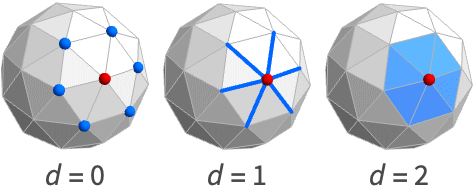AdjacentMeshCells[mr,cellspec,d]
gives cells of dimension d adjacent to the cell specified by cellspec in the mesh mr.


AdjacentMeshCells
AdjacentMeshCells[mr,cellspec,d]
gives cells of dimension d adjacent to the cell specified by cellspec in the mesh mr.
Details

- AdjacentMeshCells is also known as neighboring cells.
- Typical uses include getting cell adjacencies and topological information in a mesh.
- AdjacentMeshCells[mr,cellspec,d] returns a list of cell indices associated to the d-dimensional cells adjacent to cells specified by cellspec.
- The following cell specifications cellspec can be used:
-
{d,i} cell with index i of dimension d {d,ispec} cells with index specification ispec of dimension d {dspec,…} cells of dimensions given by dspec h[{i1,…}] explicit cell with head h and vertex indices i1, … {c1,c2,…} list of explicit cells ci - The index specification ispec can have the following form:
-
i cell index i {i1,i2,…} cells with indices ik All all cells patt cells with indices matching the pattern patt - The dimension specification dspec can have the following form:
-
d explicit dimension d All all dimensions from 0 to geometric dimension of region patt dimensions matching the pattern patt

Examples
open all close allBasic Examples (2)
Scope (5)
Basic Uses (2)
Mesh Regions (2)
The AdjacentMeshCells of a MeshRegion in 2D:
The AdjacentMeshCells of a BoundaryMeshRegion:
Polygons & Polyhedra (1)
Applications (8)
Basic Applications (5)
Adjacent mesh cells of Triangle:
Adjacent mesh cells of Cube:
Adjacent mesh cells of MengerMesh:
Adjacency Queries (1)
Use AdjacentMeshCells to find all the points that are connected to the point with cell index {0,1}:
Polyhedra Operations (1)
Use AdjacentMeshCells to compute the DualPolyhedron of a cuboid:
Get the adjacent faces for each point:
Topological Operations (1)
Use MeshConnectivityGraph to test whether a mesh is connected:
Properties & Relations (2)
The cell index {d, k} corresponds to the k![]() cells of dimension d:
cells of dimension d:
AdjacentMeshCells can be found using MeshConnectivityGraph:
Neat Examples (1)
AdjacentMeshCells of a Menger mesh:
Related Guides
History
Text
Wolfram Research (2020), AdjacentMeshCells, Wolfram Language function, https://reference.wolfram.com/language/ref/AdjacentMeshCells.html.
CMS
Wolfram Language. 2020. "AdjacentMeshCells." Wolfram Language & System Documentation Center. Wolfram Research. https://reference.wolfram.com/language/ref/AdjacentMeshCells.html.
APA
Wolfram Language. (2020). AdjacentMeshCells. Wolfram Language & System Documentation Center. Retrieved from https://reference.wolfram.com/language/ref/AdjacentMeshCells.html
BibTeX
@misc{reference.wolfram_2025_adjacentmeshcells, author="Wolfram Research", title="{AdjacentMeshCells}", year="2020", howpublished="\url{https://reference.wolfram.com/language/ref/AdjacentMeshCells.html}", note=[Accessed: 06-January-2026]}
BibLaTeX
@online{reference.wolfram_2025_adjacentmeshcells, organization={Wolfram Research}, title={AdjacentMeshCells}, year={2020}, url={https://reference.wolfram.com/language/ref/AdjacentMeshCells.html}, note=[Accessed: 06-January-2026]}